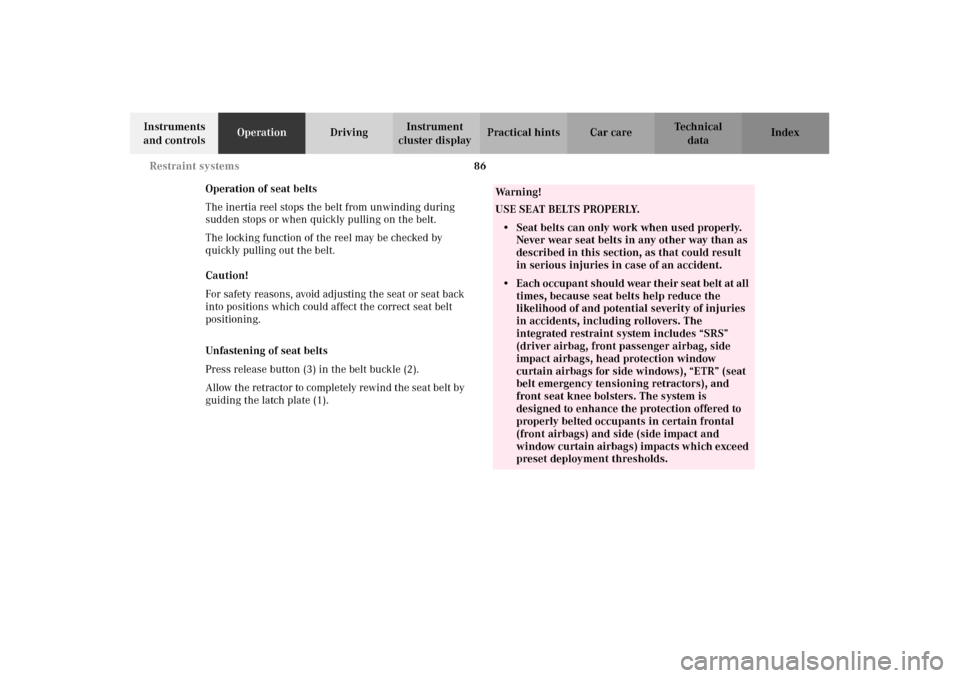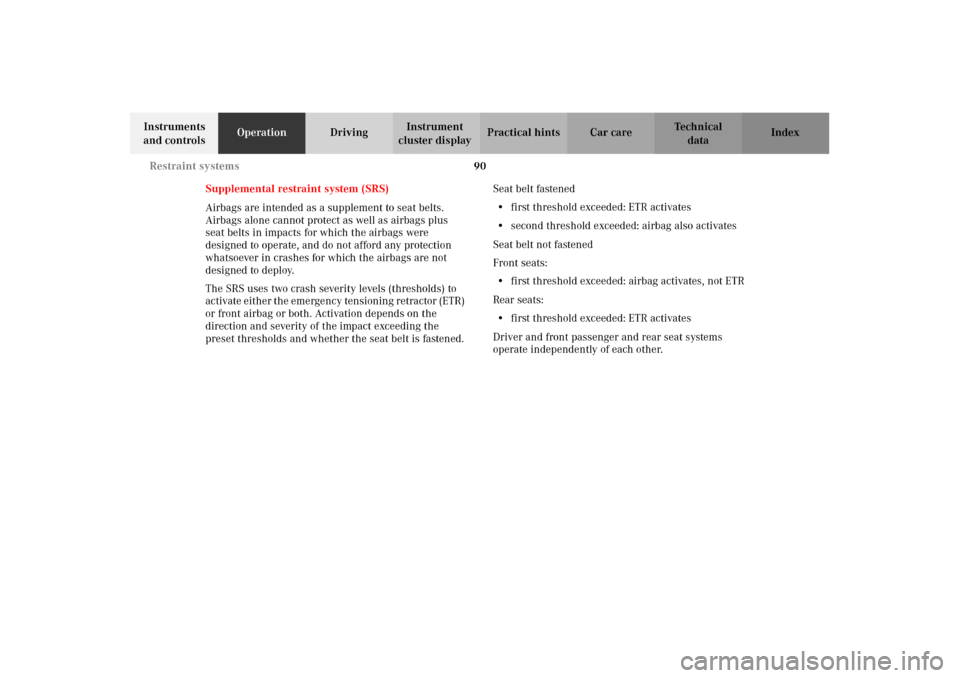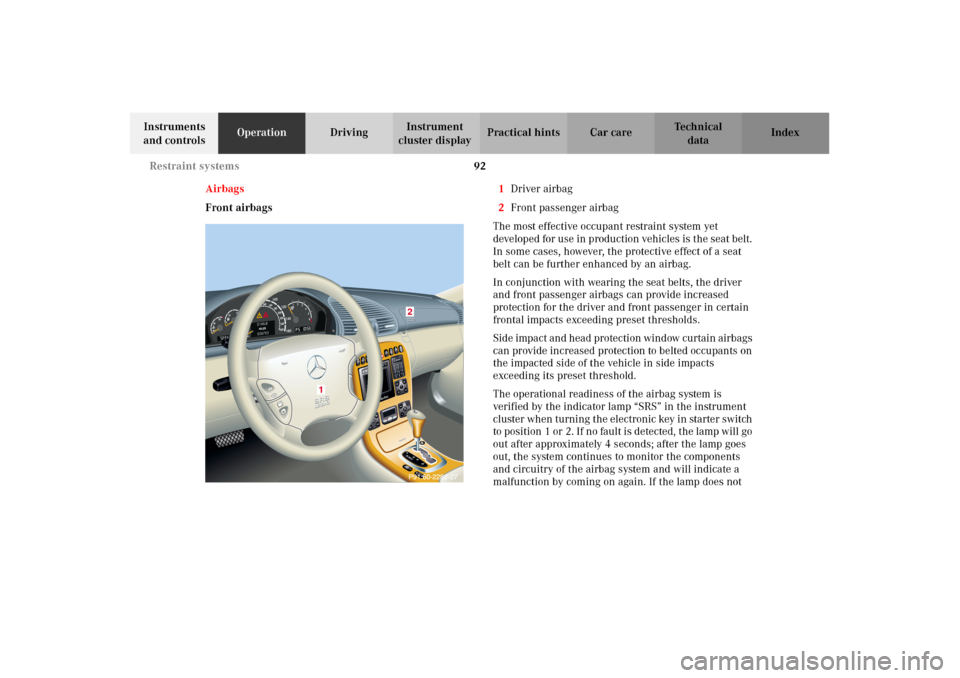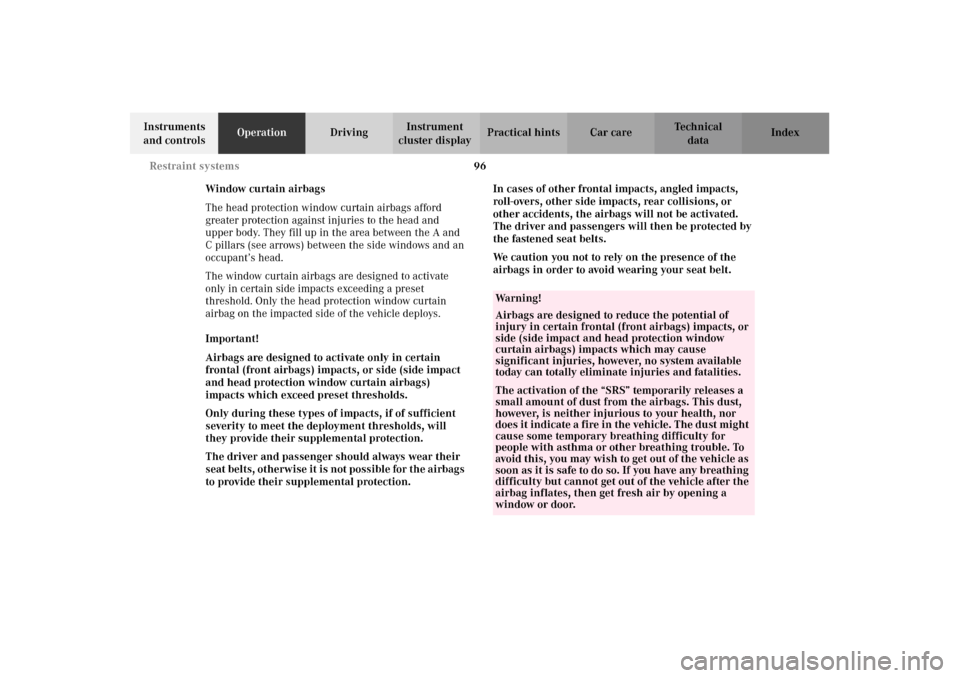Air bags MERCEDES-BENZ CL600 2002 C215 Owner's Manual
[x] Cancel search | Manufacturer: MERCEDES-BENZ, Model Year: 2002, Model line: CL600, Model: MERCEDES-BENZ CL600 2002 C215Pages: 430
Page 5 of 430

2 Contents
Supplemental restraint
system (SRS) ................................ 90
Emergency tensioning
retractor (ETR) ............................. 91
Airbags .............................................. 92
Safety guidelines for the
seat belt, emergency
tensioning retractor
and airbag .................................. 100
Infant and
child restraint systems ............. 102
Steering wheel adjustment .......... 105
Rear view mirrors .......................... 106
Rear view mirror,
automatic antiglare ................... 106
Memory function ............................111
Key dependent
memory settings ........................113
Instrument cluster ..........................114
Multifunction steering wheel,
multifunction display ............... 120
Trip and main odometer
and sub menu ............................ 124Audio systems ................................ 126
Radio ............................................ 126
CD player .................................... 127
Cassette player ........................... 128
Telephone ....................................... 129
Telephone book .......................... 129
Redialing ...................................... 131
Incoming call ...............................133
Navigation system ..........................134
Distronic (DTR) ...............................135
Trip computer .................................136
Malfunction/warning
message memory ......................138
Individual settings ........................ 140
Setting the audio volume ............. 149
Flexible service system
(FSS) ............................................150
Tire inflation pressure
monitor ........................................153
Engine oil level indicator ..............157
Engine oil consumption ................158
Exterior lamp switch ......................159
Headlamp mode ..............................160
Night security illumination ..........162Headlamp cleaning system .......... 163
Combination switch ...................... 164
Hazard warning flasher
switch .......................................... 167
Automatic climate control ............ 168
Display and controls .................. 170
Dust filter .................................... 172
Automatic maximum
cooling ......................................... 172
Basic setting ............................... 173
Special settings .......................... 174
Air recirculation ......................... 176
Activated charcoal filter ............ 177
Economy mode ........................... 178
Residual engine
heat utilization ........................... 179
Switching the
automatic climate control
on and off .................................... 180
Front center console storage
compartment ventilation .......... 180
Rear window defroster .................. 181
Rear passenger compartment
adjustable air outlets ................ 182
J_OM_215.book Seite 2 Mittwoch, 30. Mai 2001 2:01 14
Page 29 of 430

26 Contents - Operation
Te ch n i c a l
data Instruments
and controlsOperationDrivingInstrument
cluster displayPractical hints Car care Index
OperationVehicle keys ...................................... 28
Start lock-out .................................... 31
General notes on the
central locking system ............... 32
Central locking system ................... 33
Radio frequency and
infrared remote control ............... 33
KEYLESS-GO ................................. 37
Opening and closing
windows and
sliding/pop-up roof
from outside .................................. 44
Panic button .................................. 46
Mechanical keys ........................... 46
Doors .................................................. 47
Power closing assist for
doors and trunk lid ..................... 49
Central locking switch .................... 49
Automatic central locking .............. 51
Emergency unlocking
in case of accident ...................... 51
Trunk ................................................. 52
Trunk lamp ....................................... 55Trunk lid release switch ................ 56
Trunk lid release/close switch ...... 57
Trunk lid emergency release
(vehicles built prior to
September 2001) ........................ 60
Trunk lid emergency release
(vehicles built September 2001
and later) ...................................... 61
Antitheft alarm system ................... 62
Tow-away alarm ............................... 64
Easy-entry/exit feature .................. 66
Front seat adjustment ..................... 67
Removal and installation of
front seat head restraints ........... 71
Backrest ............................................ 72
Lumbar support ................................ 74
Multicontour backrest ..................... 74
Seat heater ......................................... 76
Seat ventilation system .................. 79
Power head restraints, rear ............81
Seat belts and
integrated restraint system ....... 82
Seat belts .......................................... 82Seat belt nonusage
warning system ............................ 83
BabySmart
TM airbag
deactivation system .................... 88
Self-test BabySmart
TM without
special child seat installed ......... 89
Supplemental restraint
system (SRS) ................................ 90
Emergency tensioning
retractor (ETR) ............................. 91
Airbags .............................................. 92
Safety guidelines for the
seat belt, emergency
tensioning retractor
and airbag .................................. 100
Infant and
child restraint systems ............. 102
Steering wheel adjustment .......... 105
Rear view mirrors .......................... 106
Rear view mirror,
automatic antiglare .................. 106
Memory function ............................ 111
Key dependent
memory settings ........................113
Instrument cluster ..........................114
J_OM_215.book Seite 26 Mittwoch, 30. Mai 2001 2:01 14
Page 85 of 430

82 Restraint systems
Te ch n i c a l
data Instruments
and controlsOperationDrivingInstrument
cluster displayPractical hints Car care Index
Seat belts and integrated restraint system
Your vehicle is equipped with seat belts for all seats,
emergency tensioning retractors, dual front airbags,
side impact airbags for driver, front and rear
passengers, and head protective window curtain
airbags. Their protective functions are designed to
complement one another.
Seat belts
Important!
Laws in most states and all Canadian provinces require
seat belt use.
All states and provinces require use of child restraints
that comply with U.S. Federal Motor Vehicle Safety
Standard 213 and Canadian Motor Vehicle Safety
Standard 213.
All child restraints systems are designed to be secured
in vehicle seats by lap belts or the lap belt portion of a
lap-shoulder belt.
For your safety and that of your passengers we strongly
recommend their use.
Wa r n i n g !
Children 12 years old and under must never ride in
the front seat, except in a Mercedes-Benz
authorized BabySmart
TM compatible child seat,
which operates with the BabySmart
TM system
installed in the vehicle to deactivate the passenger
side front airbag when it is properly installed.
Otherwise they will be struck by the airbag when it
inflates in a crash. If this happens, serious or fatal
injury will result.
According to accident statistics, children are safer
when properly restrained in the rear seating
positions than in the front seating positions.
Infants and small children must ride in back seats
and be seated in an appropriate infant or child
restraint system, which is properly secured with
the vehicle’s seat belt, fully in accordance with the
child seat manufacturer’s instructions.A child’s risk of serious or fatal injuries is
significantly increased if the child restraints are
not properly secured in the vehicle and the child is
not properly secured in the child restraint.
J_OM_215.book Seite 82 Mittwoch, 30. Mai 2001 2:01 14
Page 89 of 430

86 Restraint systems
Te ch n i c a l
data Instruments
and controlsOperationDrivingInstrument
cluster displayPractical hints Car care Index
Operation of seat belts
The inertia reel stops the belt from unwinding during
sudden stops or when quickly pulling on the belt.
The locking function of the reel may be checked by
quickly pulling out the belt.
Caution!
For safety reasons, avoid adjusting the seat or seat back
into positions which could affect the correct seat belt
positioning.
Unfastening of seat belts
Press release button (3) in the belt buckle (2).
Allow the retractor to completely rewind the seat belt by
guiding the latch plate (1).
Wa r n i n g !
USE SEAT BELTS PROPERLY.• Seat belts can only work when used properly.
Never wear seat belts in any other way than as
described in this section, as that could result
in serious injuries in case of an accident.• Each occupant should wear their seat belt at all
times, because seat belts help reduce the
likelihood of and potential severity of injuries
in accidents, including rollovers. The
integrated restraint system includes “SRS”
(driver airbag, front passenger airbag, side
impact airbags, head protection window
curtain airbags for side windows), “ETR” (seat
belt emergency tensioning retractors), and
front seat knee bolsters. The system is
designed to enhance the protection offered to
properly belted occupants in certain frontal
(front airbags) and side (side impact and
window curtain airbags) impacts which exceed
preset deployment thresholds.
J_OM_215.book Seite 86 Mittwoch, 30. Mai 2001 2:01 14
Page 93 of 430

90 Restraint systems
Te ch n i c a l
data Instruments
and controlsOperationDrivingInstrument
cluster displayPractical hints Car care Index
Supplemental restraint system (SRS)
Airbags are intended as a supplement to seat belts.
Airbags alone cannot protect as well as airbags plus
seat belts in impacts for which the airbags were
designed to operate, and do not afford any protection
whatsoever in crashes for which the airbags are not
designed to deploy.
The SRS uses two crash severity levels (thresholds) to
activate either the emergency tensioning retractor (ETR)
or front airbag or both. Activation depends on the
direction and severity of the impact exceeding the
preset thresholds and whether the seat belt is fastened.Seat belt fastened
•first threshold exceeded: ETR activates
•second threshold exceeded: airbag also activates
Seat belt not fastened
Front seats:
•first threshold exceeded: airbag activates, not ETR
Rear seats:
•first threshold exceeded: ETR activates
Driver and front passenger and rear seat systems
operate independently of each other.
J_OM_215.book Seite 90 Mittwoch, 30. Mai 2001 2:01 14
Page 95 of 430

92 Restraint systems
Te ch n i c a l
data Instruments
and controlsOperationDrivingInstrument
cluster displayPractical hints Car care Index
Airbags
Front airbags1Driver airbag
2Front passenger airbag
The most effective occupant restraint system yet
developed for use in production vehicles is the seat belt.
In some cases, however, the protective effect of a seat
belt can be further enhanced by an airbag.
In conjunction with wearing the seat belts, the driver
and front passenger airbags can provide increased
protection for the driver and front passenger in certain
frontal impacts exceeding preset thresholds.
Sid e imp act an d head pro tec ti on win d ow curtai n air bags
can provide increased protection to belted occupants on
the impacted side of the vehicle in side impacts
exceeding its preset threshold.
The operational readiness of the airbag system is
verified by the indicator lamp “SRS” in the instrument
cluster when turning the electronic key in starter switch
to position 1 or 2. If no fault is detected, the lamp will go
out after approximately 4 seconds; after the lamp goes
out, the system continues to monitor the components
and circuitry of the airbag system and will indicate a
malfunction by coming on again. If the lamp does not
2
1
J_OM_215.book Seite 92 Mittwoch, 30. Mai 2001 2:01 14
Page 97 of 430

94 Restraint systems
Te ch n i c a l
data Instruments
and controlsOperationDrivingInstrument
cluster displayPractical hints Car care Index
The driver and passenger front airbags are designed to
activate only in certain frontal impacts exceeding a
preset threshold. The front passenger airbag deploys
only if the front passenger seat is occupied and the
7indicator lamp on the center console is not
illuminated.Note:
Heavy objects on the front passenger seat can appear to
the “SRS” to indicate the presence of an occupant in
that seat which causes the passenger front airbag to
deploy in a crash exceeding the appropriate threshold.
J_OM_215.book Seite 94 Mittwoch, 30. Mai 2001 2:01 14
Page 98 of 430

95 Restraint systems
Te ch n i c a l
data Instruments
and controlsOperationDrivingInstrument
cluster displayPractical hints Car care Index Side impact airbags, window curtain airbags
3Side impact airbags
4Window curtain airbagsSide impact airbags
The side impact airbags are designed to activate only in
certain side impacts exceeding a preset threshold. Only
the side impact airbags on the impacted side of the
vehicle deploy.
The side impact airbag for the front passenger deploys
only if the front passenger seat is occupied.
The side impact airbag for the right rear passenger
deploys only if a preset threshold is exceeded. The side
impact airbag for the left rear passenger deploys
together with the side impact airbag for the driver.
Side impact airbags operate best in conjunction with a
properly positioned and fastened seat belt.
Note:
Heavy objects on front passenger seat can cause the
front passenger side impact airbag to deploy in a crash.
3
3
4
J_OM_215.book Seite 95 Mittwoch, 30. Mai 2001 2:01 14
Page 99 of 430

96 Restraint systems
Te ch n i c a l
data Instruments
and controlsOperationDrivingInstrument
cluster displayPractical hints Car care Index
Window curtain airbags
The head protection window curtain airbags afford
greater protection against injuries to the head and
upper body. They fill up in the area between the A and
C pillars (see arrows) between the side windows and an
occupant’s head.
The window curtain airbags are designed to activate
only in certain side impacts exceeding a preset
threshold. Only the head protection window curtain
airbag on the impacted side of the vehicle deploys.
Important!
Airbags are designed to activate only in certain
frontal (front airbags) impacts, or side (side impact
and head protection window curtain airbags)
impacts which exceed preset thresholds.
Only during these types of impacts, if of sufficient
severity to meet the deployment thresholds, will
they provide their supplemental protection.
The driver and passenger should always wear their
s eat bel ts , ot herw i se it i s n ot poss i bl e for t he a i rb ags
to provide their supplemental protection.In cases of other frontal impacts, angled impacts,
roll-overs, other side impacts, rear collisions, or
other accidents, the airbags will not be activated.
The driver and passengers will then be protected by
the fastened seat belts.
We caution you not to rely on the presence of the
airbags in order to avoid wearing your seat belt.
Wa r n i n g !
Airbags are designed to reduce the potential of
injury in certain frontal (front airbags) impacts, or
side (side impact and head protection window
curtain airbags) impacts which may cause
significant injuries, however, no system available
today can totally eliminate injuries and fatalities.The activation of the “SRS” temporarily releases a
small amount of dust from the airbags. This dust,
however, is neither injurious to your health, nor
does it indicate a fire in the vehicle. The dust might
cause some temporary breathing difficulty for
people with asthma or other breathing trouble. To
avoid this, you may wish to get out of the vehicle as
soon as it is safe to do so. If you have any breathing
difficulty but cannot get out of the vehicle after the
airbag inflates, then get fresh air by opening a
window or door.
J_OM_215.book Seite 96 Mittwoch, 30. Mai 2001 2:01 14
Page 100 of 430

97 Restraint systems
Te ch n i c a l
data Instruments
and controlsOperationDrivingInstrument
cluster displayPractical hints Car care Index Your vehicle was originally equipped with airbags
which are designed to activate in certain impacts
exceeding a preset threshold to reduce the potential
and severity of injury. It is important to your safety
a nd tha t of your pas sen ger t hat you repl ac e d epl oyed
airbags and repair any malfunctioning airbags to
ensure the vehicle will continue to provide crash
protection for occupants.
Wa r n i n g !
To reduce the risk of injury when the front airbags
inflate, it is very important for the driver and front
passenger to always be in a properly seated
position and to wear your seat belt.For maximum protection in the event of a collision
always be in normal seated position with your back
against the backrest. Fasten your seat belt and
ensure that it is properly positioned on your body.Since the airbag inflates with considerable speed
and force, a proper seating and hands on steering
wheel position will help to keep you at a safe
distance from the airbag. Occupants who are
unbelted, out of position or too close to the airbag
can be seriously injured by an airbag as it inflates
with great force in the blink of an eye:
• Sit properly belted in an upright position with
your back against the backrest.• Adjust the driver seat as far as possible
rearward, still permitting proper operation of
vehicle controls. The distance from the center
of the driver’s breastbone to the center of the
airbag cover on the steering wheel must be at
least ten inches (25 cm) or more. You should be
able to accomplish this by a combination of
adjustments to the seat and steering wheel. If
you have any problems, please see your
authorized Mercedes-Benz Center.• Do not lean with your head or chest close to the
steering wheel or dashboard.• Keep hands on the outside of steering wheel
rim. Placing hands and arms inside the rim
can increase the risk and potential severity of
hand/arm injury when driver front airbag
inflates.• Adjust the front passenger seat as far as
possible rearward from the dashboard when
the seat is occupied.
J_OM_215.book Seite 97 Mittwoch, 30. Mai 2001 2:01 14